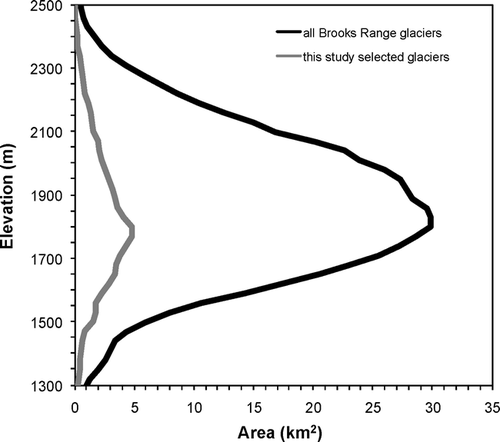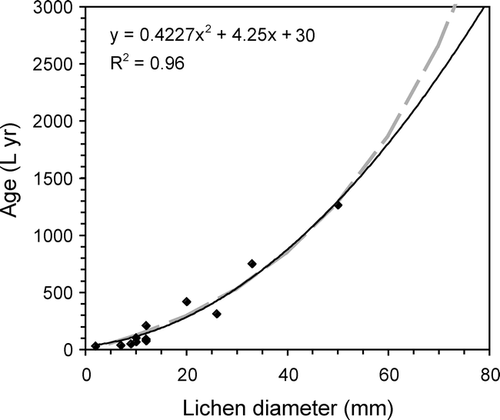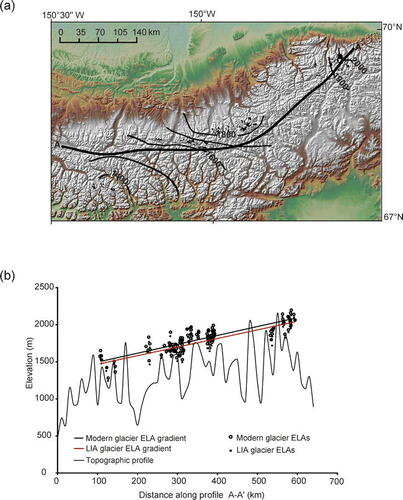Figures & data
![Figure 1 Northern Alaska showing extent of the Brooks Range (gray) and the three areas where moraines were mapped in the field (black boxes; [1] = Oolah Valley, [2] = Sagavinertok River valley, and [3] = Accomplishment Creek valley).](/cms/asset/7d88546a-7eb6-4330-beb6-9ed7fe098a3f/uaar_a_11957384_f0001.gif)
Figure 2 Area-altitude distribution of glaciers in the Brooks Range based on U.S. Geological Survey topographic maps (1970 and 1950 for the central and eastern Brooks Range, respectively). Black line is aggregate of all glaciers; gray line represents the 114 glaciers used in this study. Elevation bin size is 30 m.

Table 1 Summary statistics (mean ± 1σ) for physical parameters and estimated equilibrium-line altitudes (ELAs) for Brooks Range glaciers.
Figure 3 Typical central Brooks Range glaciers and associated Little Ice Age (LIA) moraines. Glaciers are flowing toward the north. (a) Aerial photograph of two glaciers located in the headwaters of Accomplishment Creek in 1970. The inferred LIA maximum extents of these glaciers are highlighted (dashed lines). (b) Aerial view looking south toward glacier A-2. Photograph taken in July 2003. LIA moraines have well-defined moraine crests and lack vegetation.

Figure 4 Lichen growth curve for the central Brooks Range used to date moraines in this study. Data of CitationSolomina and Calkin (2003) were fit to a least-squares second-order polynomial (curved line). The growth curve preferred by CitationSolomina and Calkin (2003) uses a logarithmic fit (dashed line), which yields older extrapolated ages for lichens beyond 2000 L yr.

Figure 5 Maps of Holocene moraines and outwash fronting five of the seven glaciers studied in the central Brooks Range. Numbers in parentheses are the single largest lichen (mm) measured on the moraine followed by its lichenometric age estimate (L yr). The transition between debris-covered glacier and rock glacier is gradational, and all debris-covered ice was mapped as a single unit. The down-slope increase in debris cover may mark the transition. Locations of glaciers as follows: O1: 68.110°N, 150.474°W; O2: 68.033°N, 150.401°W; O5: 68.036°N, 150.172°W; S5: 68.266°N, 148.451°W; S8: 68.315°N, 148.337°W.

Figure 6 Frequency histogram showing the lichenometric age distribution of moraines in the Sagavanirktok River valley and Oolah Valley. The most recent periods of moraine stabilization occurred around 700 and 300 L yr (a.d. 1250 and 1650).

Figure 7 (a) Contoured Little Ice Age (LIA) equilibrium-line altitudes (ELAs) of 114 glaciers (black shapes). Paleo-ELAs rise from southwest to northeast across the range. Contour interval is 100 m. (b) Topographic profile from A to A′ across the crest of the Brooks Range shown in (a) with the ELAs of 114 “modern” and LIA glaciers. Lines are least-squares linear regressions. “Modern” and LIA ELAs rise eastward across the range at 1.2 m km−1 (R2 = 0.71, p > 0.01).

APPENDIX Coordinates, physical parameters, and equilibrium-line altitudes (ELAs) for both extant and LIA glaciers in the Brooks Range, Alaska. Listed from west to east.